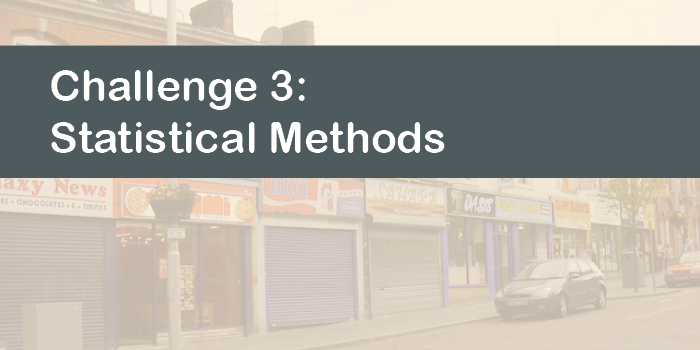Linking the built environment and obesity: five key challenges
Elevated obesity prevalence is concerning due to the associated individual and societal consequences. There have been mixed findings for public health interventions, with many only achieving short-term success in weight loss (Padwal, 2007). Policymakers are therefore engaging with the idea that the built environment may be a contributing factor to obesity. For instance, within the US and UK, policy initiatives that restrict the location of fast food outlets around areas such as schools are being considered to help curb obesity prevalence. Furthermore, the UK government only very recently published its £1.2 billion long-term plan acknowledging the importance of a healthy environment.
Despite this policy movement, research shows little or no association between the built environment and obesity, with many studies having conflicting results (Cobb et al. 2015, Mackenbach et al. 2014). Numerous systematic reviews have sought to synthesise the available evidence. However this has been made challenging due to the variety of methods employed in the literature. Reviews have therefore largely failed to reach a consensus on whether the built environment is a driver of obesity. This leaves policymakers lacking clear guidance on whether and how to best intervene at a population level to improve ‘obesogenic environments’. Below, we highlight five challenges to overcome before the evidence-base can move forward.
Secondary data (i.e. data collected for purposes other than answering the specific research question it is applied to) is commonly used in built environment-obesity research to characterise aspects of the environment, such as the locations of food outlets and recreation facilities, areas of green space, and the layout of road systems. It is often used in preference to primary data (collected via street audits) due to its perceived economy. However, little is known about the validity of secondary data available in the UK. Invalid secondary data could lead to uncertainty and bias in food access measures, which may in turn help explain the mixed evidence in relation to the links between the built environment and obesity.
Progress is being made towards better understanding the validity of commonly used secondary data sources. For example, researchers at Leeds Beckett University and the Leeds Institute for Data Analytics (LIDA) are currently undertaking work to validate two commonly used sources of secondary food environment data (Ordnance Survey Points of Interest data, and data from the Food Standards Agency) (Wilkins et al., under review). A better understanding of these datasets and any possible biases that exist will help inform future research and policy tools.
Currently, systematic reviews highlight considerable inconsistencies in study findings, which are suggested to be due to different methods employed between studies (methodological heterogeneity). Research is therefore beginning to explore how methodological choices such as selection of secondary data sources, classification of food outlets and definition of a neighbourhood may influence conclusions (Hobbs et al. 2017). However, in the absence of any evidence on the impact of methodological heterogeneity, comparisons between studies are near impossible; potentially explaining why there has been no meta-analysis to date, despite several systematic reviews.
Moving forward, it may be difficult to achieve standardised methods within environmental research, particularly given the nature of individual behaviours. However, it is important to rigorously challenge the choices made at a methodological level. Researchers should consider and where possible transparently report (in a sensitivity analysis) the impact of methodological choices, such as the definition of neighbourhood on associations between the environment and obesity. Researchers could use the local context and problem being investigated to inform the most appropriate measures i.e. secondary dataset used; that is, until better evidence emerges to guide methodological choices (Hobbs et al. 2017).
In addition to a diversity of measures and definitions employed, comparison between studies is also made challenging by the diversity of statistical methods employed. Two important considerations are adjustment for covariates and classification of the environment i.e. count of food outlets, quartiles, tertiles, or by an arbitrary low, medium, and high number of outlets. The use of different cut points to define access makes comparability between studies challenging e.g. an area of ‘low access’ in a densely populated area will not be equivalent to an area of ‘low access’ in a sparse, rural area. Additionally, these cut-points are often not reported (Lamb et al. 2015).
The importance of adjusting for different covariates is also highlighted within a recent paper which showed evidence of an association between fast-food outlets and body mass index (BMI) (Burgoine et al., 2014). Although, the main exposure was fast-food, the paper states that “adjustment for supermarkets proved to be critical in the analysis”, such that in models that omitted supermarkets as a covariate, the associations between fast-food outlets and BMI were attenuated and no longer significant. Importantly, at present there is by no means ‘a correct way’ to adjust for covariates. However, there needs to be appreciation that different adjustment sets may result in practically important differences in outcomes. Moving forward, covariate selection should be guided and supported by a clearly articulated causal framework.
Not only are methods very diverse within built environment-obesity research, but (possibly due to tight word limits imposed by journals) methods are also often not reported in sufficient detail to appraise and interpret research findings. For example, very few studies into the links between the food environment and obesity provide adequate definitions of the types of food outlets under investigation. ‘Fast food outlets’ for example have been defined very differently in the literature, with narrow definitions including only ‘traditional’ hot food takeaways (e.g. selling burger, pizza, fried chicken etc. to take away), and broader definitions including e.g. cafes and retail bakeries. Lack of information about how outlet types are defined leaves policymakers with a lack of clarity about which types of food outlets to target within interventions. These issues have recently been recognised by researchers at LIDA and Leeds Beckett University, who developed the GeoFERN (Geographic Information Systems Food Environment ReportiNg) checklist to support researchers in reporting methods in food environment-obesity research (Wilkins et al., 2017).
Currently, evidence linking the environment and obesity relies mostly on geographical access to the food or physical activity environment (based on objectively measured distances or densities). However, recent literature suggests we may need to account for other environmental influences i.e. individual perceptions to consider how the environment may more holistically influence BMI or obesity. For instance, recent studies have also shown that in order to understand the association between the food environment and BMI or diet, both geographic (i.e. actual access) and economic accessibility (i.e. affordability) measures of the food environment were required (Mackenbach et al. 2017). Secondary data sources may not always contain data on economic accessibility or other wider influences. However, in order to detect the true effect of the obesogenic environment it may be important to embrace complexity, consider wider environmental influences and explore or develop other sources of secondary data which contain such potentially valuable information.
Conclusion
It is reasonable to assume that there is a relationship between the environment and obesity, and it is encouraging to see that policymakers are taking an interest and action. Further to this, we also acknowledge that policy does not have to wait until the perfect evidence base is formed in order to make policy changes (Griffiths et al. 2017). However, in terms of moving research forward to support policy, the above challenges need greater consideration before research can advance to support policy engagement and action. Leeds Beckett University, the Leeds Institute for Data Analytics and Leeds Trinity University, together with ESRC Obesity Network are working to address some of these challenges, so watch this space!
For any comments please get in touch with either Emma or Matthew on e.wilkins@leedsbeckett.ac.uk or m.hobbs@leedstrinity.ac.uk. Or follow us on Twitter (@WilksEms, @Hobbs_PA).
Emma Wilkins is a Researcher in Obesity, Nutrition, Data Analytics and Health Geography. Based at Leeds Beckett University and the University of Leeds (Leeds Institute for Data Analytics) since February 2016, her research focuses on the use of ‘Big Data’ to understand how the built environment affects diet and obesity.
Key references
- Burgoine, T., Forouhi, N. G., Griffin, S. J., Wareham, N. J., & Monsivais, P. 2014. Associations between exposure to takeaway food outlets, takeaway food consumption, and body weight in Cambridgeshire, UK: population based, cross sectional study. BMJ, 348, 1-10.
- Cobb, L. K., Appel, L. J., Franco, M., Jones-Smith, J. C., Nur, A. & Anderson, C. A. 2015. The relationship of the local food environment with obesity: A systematic review of methods, study quality, and results. Obesity, 23, 1331-44.
- Griffiths, C., Wilkins, E. & Morris, M. 2016. Associating food environments with obesity? The Journal of the Town and Country Planning Association, 85, 465.
- Hobbs, M., Green, M., Griffiths, C., Jordan, H., Saunders, J. & Mckenna, J. 2017. How different data sources and definitions of neighbourhood influence the association between food outlet availability and body mass index: a cross-sectional study. Perspectives in Public Health, 137, 158-161.
- Lamb, K. E. & White, S. R. 2015. Categorisation of built environment characteristics: the trouble with tertiles. International Journal of Behavioral Nutrition and Physical Activity, 12.
- Mackenbach, J. D., Burgoine, T., Lakerveld, J., Forouhi, N. G., Griffin, S. J., Wareham, N. J. & Monsivais, P. 2017. Accessibility and Affordability of Supermarkets: Associations With the DASH Diet. American Journal of Preventive Medicine.
- Mackenbach, J. D., Rutter, H., Compernolle, S., Glonti, K., Oppert, J.-M., Charreire, H., De Bourdeaudhuij, I., Brug, J., Nijpels, G. & Lakerveld, J. 2014. Obesogenic environments: a systematic review of the association between the physical environment and adult weight status, the SPOTLIGHT project. BMC Public Health, 14, 233.
- Padwal, R. 2007. Long term pharmacotherapy for obesity and overweight: updated meta-analysis. British Medical Journal, 335, 1194-1199.
- Wilkins, E. L., Morris, M. A., Radley, D. & Griffiths, C. 2017. Using Geographic Information Systems to measure retail food environments: Discussion of methodological considerations and a proposed reporting checklist (Geo-FERN). Health Place, 44, 110-117.
- Wilkins, E. L., Radley, D., Morris, M. A. & Griffiths, C. (under review) Examining the validity and utility of two secondary sources of food environment data against street audits in England. Nutrition Journal.





